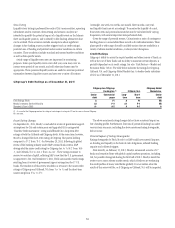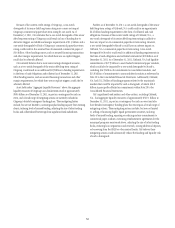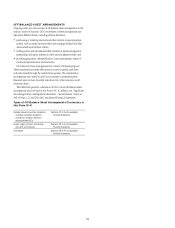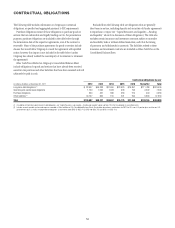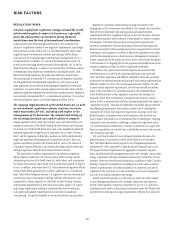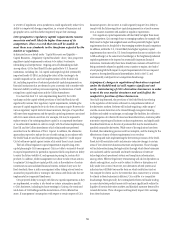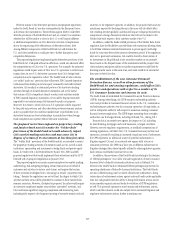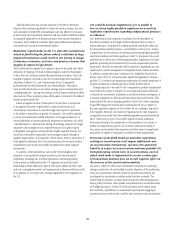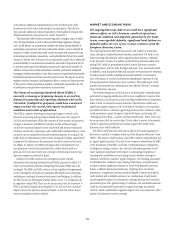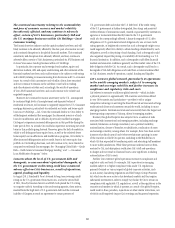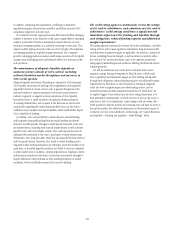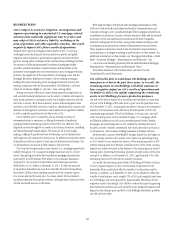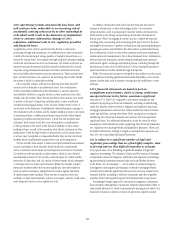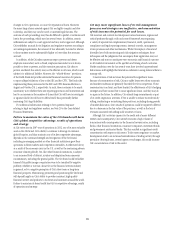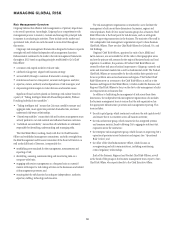Citibank 2011 Annual Report Download - page 81
Download and view the complete annual report
Please find page 81 of the 2011 Citibank annual report below. You can navigate through the pages in the report by either clicking on the pages listed below, or by using the keyword search tool below to find specific information within the annual report.59
and extensive additional requirements for review and disclosure of the
characteristics of the assets underlying the securitizations. The SEC has
also proposed additional extensive regulation of both publicly and privately
offered securitization transactions (so-called “Reg AB II”).
The cumulative effect of these extensive regulatory changes, many of which
have not been finalized, as well as other potential future regulatory changes,
such as GSE reform, on securitization markets, the nature and profitability of
securitization transactions, and Citi’s participation therein, cannot currently be
assessed. It is likely, however, that these various measures will increase the costs
of executing securitization transactions, and could effectively limit Citi’s overall
volume of, and the role Citi may play in, securitizations, expose Citi to additional
potential liability for securitization transactions and make it impractical for Citi
to execute certain types of securitization transactions it previously executed. In
addition, certain sectors of the securitization markets, particularly residential
mortgage-backed securitizations, have been inactive or experienced dramatically
diminished transaction volumes since the financial crisis. The impact of various
regulatory reform measures could negatively delay or restrict any future recovery
of these sectors of the securitization markets, and thus the opportunities for Citi
to participate in securitization transactions in such sectors.
The Financial Accounting Standards Board (FASB) is
currently reviewing or proposing changes to several key
financial accounting and reporting standards utilized by
Citi which, if adopted as proposed, could have a material
impact on how Citi records and reports its financial
condition and results of operations.
The FASB is currently reviewing or proposing changes to several of the
financial accounting and reporting standards that govern key aspects of
Citi’s financial statements. While the outcome of these reviews and proposed
changes is uncertain and difficult to predict, certain of these changes
could have a material impact on how Citi records and reports its financial
condition and results of operations, and could hinder understanding or cause
confusion across comparative financial statement periods. For example, the
FASB’s financial instruments project could, among other things, significantly
change how Citi determines the impairment on those assets and accounts
for hedges. In addition, the FASB’s leasing project could eliminate most
operating leases and instead capitalize them, which would result in a
gross-up of Citi’s balance sheet and a change in the timing of income and
expense recognition patterns for leases.
Moreover, the FASB continues its convergence project with the
International Accounting Standards Board (IASB) pursuant to which U.S.
GAAP and International Financial Reporting Standards (IFRS) are to be
converged. The FASB and IASB continue to have significant disagreements
on the convergence of certain key standards affecting financial reporting,
including accounting for financial instruments and hedging. In addition,
the SEC has not yet determined whether, when or how U.S. companies will
be required to adopt IFRS. There can be no assurance that the transition to
IFRS, if and when required to be adopted by Citi, will not have a material
impact on how Citi reports its financial results, or that Citi will be able to
meet any required transition timeline.
MARKET AND ECONOMIC RISKS
The ongoing Eurozone debt crisis could have significant
adverse effects on Citi’s business, results of operations,
financial condition and liquidity, particularly if it leads
to any sovereign debt defaults, significant bank failures or
defaults and/or the exit of one or more countries from the
European Monetary Union.
The ongoing Eurozone debt crisis has caused, and is likely to continue to
cause, disruption in global financial markets, particularly if it leads to any
future sovereign debt defaults and/or significant bank failures or defaults
in the Eurozone. In spite of a number of stabilization measures taken since
spring 2010, yields on government bonds of certain Eurozone countries,
including Greece, Ireland, Italy, Portugal and Spain, have remained volatile.
In addition, some European banks and insurers have experienced a widening
of credit spreads (and the resulting decreased availability and increased
costs of funding) as a result of uncertainty regarding the exposure of such
European financial institutions to these countries. This widening of credit
spreads and increased cost of funding has also affected Citi due to concerns
about its Eurozone exposure.
The market disruptions in the Eurozone could intensify or spread further,
particularly if ongoing stabilization efforts prove insufficient. Concerns have
been raised as to the financial, political and legal ineffectiveness of measures
taken to date. Continued economic turmoil in the Eurozone could have a
significant negative impact on Citi, both directly through its own exposures
and indirectly due to a decline in general global economic conditions, which
could particularly impact Citi given its global footprint and strategy. See
“Managing Global Risk—Country and Cross-Border Risk” below. There can
be no assurance that the various steps Citi has taken to protect its businesses,
results of operations and financial condition against the results of the
Eurozone crisis will be sufficient.
The effects of the Eurozone debt crisis could be even more significant if
they lead to a partial or complete break-up of the European Monetary Union
(EMU). The partial or full break-up of the EMU would be unprecedented and
its impact highly uncertain. The exit of one or more countries from the EMU
or the dissolution of the EMU could lead to redenomination of obligations
of obligors in exiting countries. Any such exit and redenomination would
cause significant uncertainty with respect to outstanding obligations of
counterparties and debtors in any exiting country, whether sovereign or
otherwise, and lead to complex, lengthy litigation. The resulting uncertainty
and market stress could also cause, among other things, severe disruption
to equity markets, significant increases in bond yields generally, potential
failure or default of financial institutions, including those of systemic
importance, a significant decrease in global liquidity, a freeze-up of global
credit markets and worldwide recession. Any combination of such events
would negatively impact Citi’s businesses, earnings and financial condition,
particularly given Citi’s global strategy. In addition, exit and redenomination
could be accompanied by imposition of capital, exchange and similar
controls, which could further negatively impact Citi’s cross-border risk, other
aspects of its businesses and its earnings.




